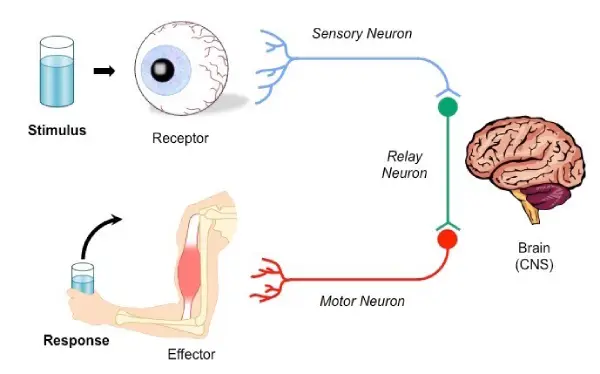What is Reaction Time and Why Does It Matter?
Ever slammed on the brakes to avoid a sudden obstacle? Or maybe you've clicked your mouse just in time to win a crucial moment in a game? These quick responses are powered by something fundamental: your reaction time. But what is reaction time, exactly, and why should you care about it? This guide will break down the definition, explore its real-world importance, and show you how you can easily measure yours with a simple online reaction time test.

Defining Reaction Time: More Than Just Reflex Speed
Many people use "reaction time" and "reflexes" interchangeably, but they aren't quite the same. So, what is the actual reaction time definition?
The Stimulus-Response Cycle Explained
At its core, reaction time is the duration it takes for your body to detect an external stimulus, process that information in your brain, and then initiate a voluntary response. Think of it as a three-step process:

- Perception: Your senses (like sight or hearing) detect a change or signal (the stimulus).
- Processing: Your brain interprets the signal and decides on an appropriate action.
- Response: Your brain sends signals to your muscles to perform the action. The time taken for these three steps combined is your reaction time.
Cognitive Processing: The Brain's Role
Unlike a simple reflex (like pulling your hand from a hot stove, which bypasses conscious thought), reaction time involves cognitive processing. Your brain actively works to understand the stimulus and choose the right response. This mental processing step is a key component of your overall reaction time.
Reaction Time vs. Movement Time
It's also important to distinguish reaction time from movement time. Reaction time is only the time it takes to start responding after detecting the stimulus. Movement time is the additional time it takes to complete the physical action itself. For example, seeing a green light (stimulus), deciding to press the gas pedal (processing), and the moment your foot begins to move towards the pedal is reaction time. The time it takes for your foot to actually press the pedal down is movement time.
Why Your Reaction Time Matters: Real-World Importance
Understanding the importance of reaction time goes beyond simple curiosity. It plays a crucial role in numerous aspects of our lives. Why does reaction time matter so much?
Everyday Safety and Decision Making
From driving a car to crossing the street or even catching a falling object, quick decision making based on fast reaction times can prevent accidents and keep you safe. A split-second delay can sometimes make all the difference.
Performance Boost in Gaming and Sports
For athletes and gamers, reaction time is often a critical factor for success. Whether it's a sprinter launching off the blocks, a goalie saving a shot, or a gamer executing a complex maneuver, superior gaming performance and athletic prowess often rely on lightning-fast reactions. Improving your reaction speed can give you a competitive edge.

Critical Factor for Drivers
Perhaps one of the most critical areas is driving safety. A driver's reaction time directly impacts their braking distance. Being able to react quickly to unexpected events on the road – like a car suddenly stopping ahead – is essential for avoiding collisions.
How We Measure Reaction Time: The Visual Test Explained
Now that you understand what reaction time is and why it's important, you might be wondering: how is reaction time measured?
Common Ways to Test Reaction Speed
There are various methods, from complex laboratory setups to simple online tools. Many tests involve responding to a visual stimulus or an auditory cue. The goal is always to measure the interval between the stimulus presentation and the initiation of your response.
How ReactionTimeTest.net Works (Red to Green Signal)
Our website offers a straightforward and accessible way to measure reaction time. We use a simple visual test:

- You'll see a colored area on the screen, initially red.
- Click "Start", and focus on the red area.
- After a random delay, the color will instantly change to green.
- As soon as you see the green visual stimulus, click your mouse (or tap your screen) as quickly as possible. This method specifically tests your visual reaction time. You can try our visual reaction test right now.
Understanding Your Score in Milliseconds (ms)
Your result on our reaction test is displayed in milliseconds (ms) – thousandths of a second. A lower score indicates a faster reaction time. Understanding typical scores can help put your own performance into perspective (we'll cover average scores in another article!).
Is Reaction Time Different from Reflexes? Clearing the Confusion
Let's quickly revisit the difference between reaction time and reflexes. Is reaction time different from reflexes? Yes, fundamentally.
Defining Reflex Actions
A reflex action is an involuntary, near-instantaneous movement in response to a stimulus. It's processed through the spinal cord, often bypassing conscious thought in the brain for maximum speed (like the knee-jerk reflex).
Key Differences Summarized
- Control: Reaction time involves voluntary responses; reflexes are involuntary.
- Processing: Reaction time involves conscious brain processing; reflexes often bypass it.
- Speed: Reflexes are generally faster than reaction times because they involve fewer neural connections.
Ready to Check Your Reaction Time? Key Takeaways & Next Steps
So, we've established that reaction time is the interval between sensing a stimulus and initiating a voluntary response. It involves cognitive processing and is crucial for safety, performance in sports and gaming, and everyday activities. It's distinct from involuntary reflexes and simple movement speed.
Knowing your reaction time can be both insightful and useful. Ready to check your reaction time?
Taking a simple reaction speed test like the one offered here provides a baseline understanding of your current capabilities. It's the first step towards potentially improving your responsiveness.
Reaction Time FAQ: Your Questions Answered
Here are answers to some common questions about reaction time basics:
What is considered a typical human reaction time?
While it varies greatly based on factors like age, alertness, and the type of stimulus, the average reaction time for a visual stimulus is often cited as being around 200-300 milliseconds (ms). You can use our tool to discover your personal benchmark.
Can simple reaction time be improved with practice?
Yes! While there's a genetic component, reaction time training and consistent practice using tools or specific exercises can often lead to noticeable improvements in human reaction time. We'll explore methods on how to improve reaction time in future posts.
Does reaction time change with age?
Generally, reaction time tends to be quickest in young adulthood (around the early to mid-20s) and gradually slows down with increasing age. However, individual variations are significant, and lifestyle factors play a large role.